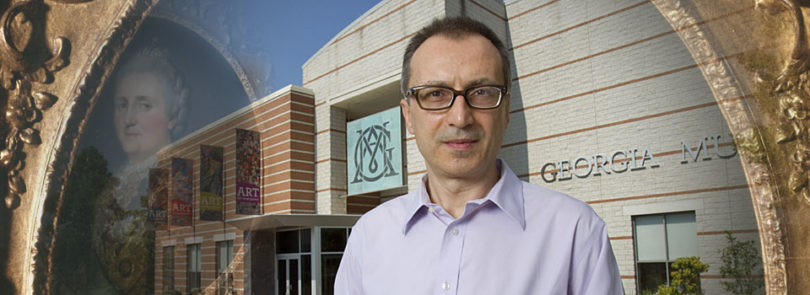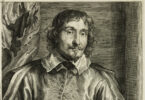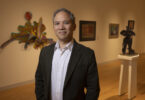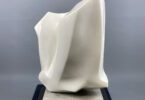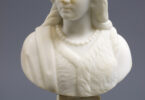Art has the ability to tell stories through objects. The story of how a Lutheran princess became the most powerful Russian empress in history and how her journey uplifted a nation can be seen through her art collection, which is on display at the Georgia Museum of Art until Jan. 5.
“We have assembled a group of stunning objects of art to explain something essential about 18th century culture, about the cultural connectivity of Catherine the Great as a philosopher, collector, patron of art and empress,” said Asen Kirin, associate professor of art history and associate director of UGA’s Lamar Dodd School of Art, who curated the exhibition. “The show is about the dynamic between collecting historical art and commissioning new works of art. It is also about a person’s ability to invent and affirm a sense of cultural identity through works of art and intellectual pursuits.”
Kirin has spent nearly 20 years studying Catherine the Great, both in his native Bulgaria and Russia before coming to the U.S. to continue his study of ancient arts and architecture of the Eastern Roman Empire. He approached museum Director William U. Eiland with the idea for the exhibition to share his research with the UGA community.
His knowledge of Russian art grew during the years he spent in Moscow.
“In terms of message, intention and symbolic messages, it (Russian art) was so directly related to the medieval intellectual artistic tradition I was studying,” he said. “I found that to be most fascinating, after I started studying these themes, and some of these remarkable objects were directly associated with art patronage of the medieval era.”
During his research, Kirin began decoding the messages in Catherine’s collection.
“I thought, this is insane,” he said about the famous Wedgwood Green Frog Service, which is the most elaborate and expensive set ever commissioned.
Pieces from this iconic dinner set, along with others, will be featured in the exhibition Kirin assembled, “Exuberance of Meaning: The Art Patronage of Catherine the Great (1762-1796).” The title “Exuberance of Meaning” refers to a crucial characteristic that distinguishes Catherine the Great’s endeavors in the arts, according to Kirin.
“Her innumerable projects-whether a new city, a church, a liturgical vessel or a dinner set-were conceived in a manner allowing for multiple, yet complementary, interpretations covering a wide spectrum of meanings,” he said.
Kirin said the exhibition illustrates the way an object can be infused with cultural meanings that enrich the viewers’ experience and how this contributes to the way those viewers ultimately define themselves and establish their place in the world. The culmination of years of research, the exhibition explores the idea of how to deal with the notion of cultural displacement and how to use art knowledge as a way to define a cultural identity.
While movement from place to place and between classes is common today, it was unusual, even among those with crowned heads, in the era of Catherine the Great. Born a protestant, Lutheran princess, in Prussia as a German speaker, Catherine became an Eastern-Orthodox Russian tsarina.
“While re-inventing herself, she contributed to a Russian cultural identity defined by the ideas of the Enlightenment, the heritage of pagan antiquity and the Eastern Orthodox faith,” Kirin explained. “In addition to her political and administrative reforms, Catherine used art, architecture and literature to elevate the culture and better the life of the entire nation.”
This exhibition features works of decorative art the Russian empress commissioned for her own use or as gifts for churches and courtiers.
According to Kirin, the Buch chalice, created by noted goldsmith Iver Winfeldt Buch and on loan from the Hillwood Museum and Gardens in Washington, D.C., serves as the centerpiece of the exhibition. It is a solid gold vessel adorned with scores of diamonds and eight cameos that Catherine the Great herself selected from her collection.
“This remarkable object demonstrates the particular manner in which Catherine the Great used both her knowledge of ancient and medieval glyptic art and her actual collection of carved gems in new works of art that she commissioned,” he said. “To illustrate this phenomenon, carved gems and depictions of them constitute the theme linking the majority of the objects in the current exhibition.”
The show focuses on three realms: scholarship and intellectual pursuits, liturgical services and religious devotion, and the experience of dining. In each of these three sections, works of art enable certain forms of transcendence.
“They create the experience of overcoming the limitations of one’s physical existence in that place and moment,” he said. “In this context, the term transcendence is with regard to cultural anthropology as an elevating activity that enriches life and surpasses the sphere of maintaining basic human existence.”
The current exhibition borrows objects from the Metropolitan Museum of Art, Dumbarton Oaks/Harvard University, the Birmingham Museum of Art, Walters Art Museum, the Michael C. Carlos Museum/Emory University, the Chipstone Foundation and several private collections. The main lender for this show is Hillwood Museum and Gardens, Washington, D.C., established by Marjorie Merriweather Post (1887-1973), the distinguished art collector, philanthropist and businesswoman.


